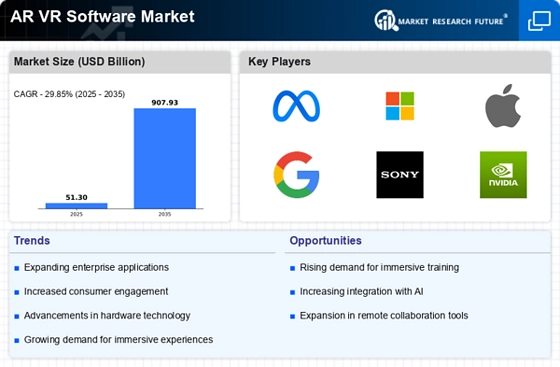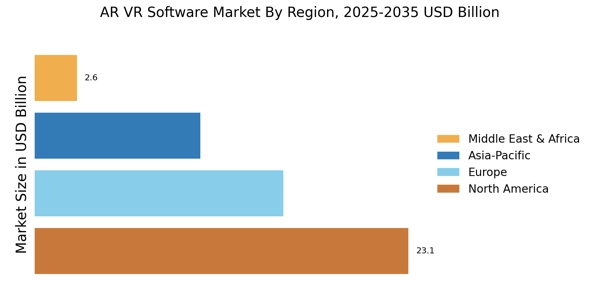The AR VR Software Market is currently characterized by a dynamic competitive landscape, driven by rapid technological advancements and increasing demand across various sectors, including gaming, education, and healthcare. Major players such as Meta Platforms (US), Microsoft (US), and Apple (US) are at the forefront, each adopting distinct strategies to enhance their market positioning. Meta Platforms (US) continues to focus on immersive social experiences, leveraging its extensive user base to integrate AR and VR into everyday interactions. Meanwhile, Microsoft (US) emphasizes enterprise solutions, particularly through its Azure cloud services, which support AR applications in industrial settings. Apple (US), on the other hand, appears to be concentrating on consumer hardware integration, with its anticipated AR headset expected to redefine user engagement. Collectively, these strategies indicate a competitive environment that is increasingly centered around innovation and user experience.
In terms of business tactics, companies are increasingly localizing their operations and optimizing supply chains to enhance efficiency and responsiveness to market demands. The AR VR Software Market is moderately fragmented, with a mix of established players and emerging startups. This fragmentation allows for diverse offerings but also intensifies competition among key players, who are vying for market share through strategic partnerships and technological advancements.
In September 2025, Meta Platforms (US) announced a partnership with a leading educational institution to develop AR-based learning tools aimed at enhancing student engagement. This initiative not only underscores Meta's commitment to expanding its AR applications but also positions the company as a key player in the educational technology sector, potentially opening new revenue streams. The strategic importance of this move lies in its ability to leverage Meta's existing platform while addressing the growing demand for innovative educational solutions.
In August 2025, Microsoft (US) launched a new version of its HoloLens, specifically designed for remote collaboration in manufacturing environments. This release highlights Microsoft's focus on enhancing productivity through AR technology, particularly in sectors that require real-time data visualization and collaboration. The strategic significance of this development is evident in its potential to solidify Microsoft's position as a leader in enterprise AR solutions, catering to the needs of businesses seeking to optimize operations.
In July 2025, Apple (US) unveiled its latest AR headset, which integrates seamlessly with its existing ecosystem of devices. This launch is pivotal as it not only showcases Apple's commitment to AR technology but also reinforces its strategy of creating a cohesive user experience across its product lines. The implications of this move are profound, as it may drive consumer adoption of AR applications, further entrenching Apple in the competitive landscape.
As of October 2025, current trends in the AR VR Software Market are heavily influenced by digitalization, sustainability, and the integration of artificial intelligence. Strategic alliances are becoming increasingly vital, as companies recognize the need to collaborate to enhance technological capabilities and market reach. Looking ahead, competitive differentiation is likely to evolve, shifting from traditional price-based competition to a focus on innovation, technological advancement, and supply chain reliability. This transition suggests that companies that prioritize these aspects will be better positioned to thrive in an increasingly competitive environment.


















Leave a Comment